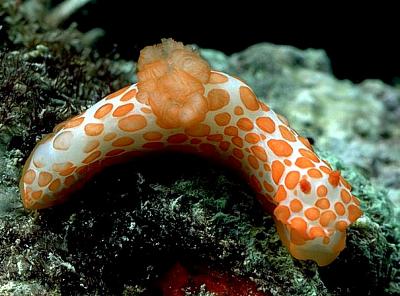
Gymnodoris rubropapulosa
(Bergh, 1905)
Order: NUDIBRANCHIA
Suborder: DORIDINA
Superfamily: ANADORIDOIDEA
Family: Gymnodorididae
DISTRIBUTION
Indo-West Pacific
PHOTO
UPPER RIGHT: Channel between Récif de l'Infernet & Barrier Reef, off Koumac, New Caledonia, 20°38.6'S, 164°13.2'E, 12m, in lagoon, grey sand, coral slabs, 11 October 1993, 60mm long alive, AM C200433. LOWER LEFT: 6km N of Kunduchi Beach, Dar es Salaam, Tanzania, in grass beds. 6 February 1974. LOWER RIGHT: Lagoon between mainland and Récif de l'Infernet, off Koumac, New Caledonia, 20°35.6'S, 164°15.2'E, 10m, sand and grey mud, 28 October 1993, [Lower animal 43mm long alive, AM C200687. Upper animal AM C200594]. PHOTOS: Bill Rudman.
Previously known from Indonesia and Singapore and recently reported from Hong Kong and Tanzania (Rudman & Darvell, 1990), this species has a wide Indo-West Pacific distribution. It has similarities in colour pattern to G. ceylonica but the orange spots are much larger and more densely arranged, the body is more elongate and the gills relatively small. There are also major anatomical differences.
Reference:
• Bergh, L.S.R. (1905). Die Opisthobranchiata. Siboga Expeditie Report, 50: 248pp., Pls 1-20.
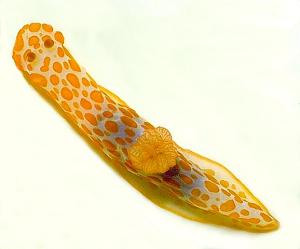
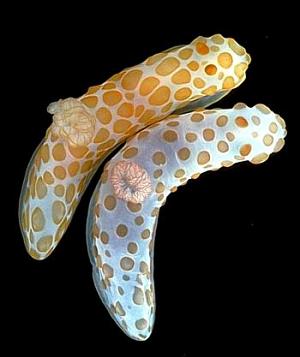
Rudman, W.B., 2000 (December 29) Gymnodoris rubropapulosa (Bergh, 1905). [In] Sea Slug Forum. Australian Museum, Sydney. Available from http://www.seaslugforum.net/find/gymnrubr
Related messages
Gymnodoris from Larak Island, Iran
May 3, 2010
From: Mahdi Moradi Och Tapeh
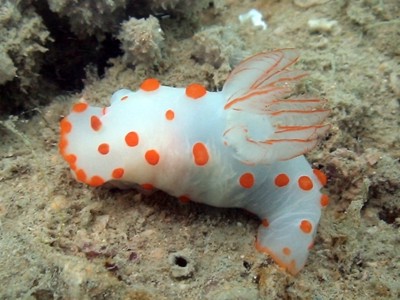
In duration my researches on Coral Reef in Persian Gulf I did find these species on coral Reef bed in Larak & Qeshm Island, and I need to your guidance about identification and biology information of this species?
Locality: Larak Island - Bandar abbas, 2m, Iran , Persian Gulf , 23 July 208, N 26 49' 35.2", E 56 19' 20.2". Length: 3.5cm. Photographer: Mohammad Sharif Ranjbar.
Best Regards
Mahdi Moradi
biologymoradi@gmail.com
Moradi, M., 2010 (May 3) Gymnodoris from Larak Island, Iran. [Message in] Sea Slug Forum. Australian Museum, Sydney. Available from http://www.seaslugforum.net/find/23596Dear Mahdi,
This is Gymnodoris rubropapulosa. It usually has more orange spots than in your specimens, but the raised and rounded tubercles, and spots right at the edge are characteristic. If you look at earlier messages on the Forum about this species you will see it feeds on other opisthobranchs
Best wishes,
Bill Rudman
Re: Gymnodoris rubropapulosa feeding
January 15, 2009
From: Toh Chay Hoon
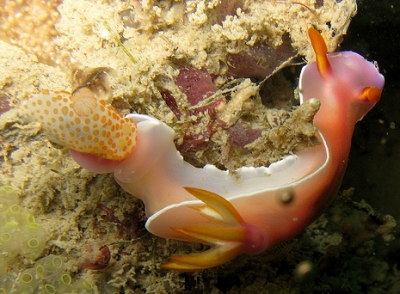
Concerning message #21507:
Dear Dr Bill,
here's another photo of Gymnodoris rubropapulosa caught in acton of feeding during my recent dive at Pulau Hantu.
I would love to see if it can really finish the bigger prey but unfortunately I was running low on air.
Locality: Pulau Hantu, 7m, Singapore, South China Sea, 20 December 2008, Silty substrate. Length: 25 mm. Photographer: Toh Chay Hoon.
Toh Chay Hoon
sonnenflower@gmail.com
Toh C.H., 2009 (Jan 15) Re: Gymnodoris rubropapulosa feeding. [Message in] Sea Slug Forum. Australian Museum, Sydney. Available from http://www.seaslugforum.net/find/22114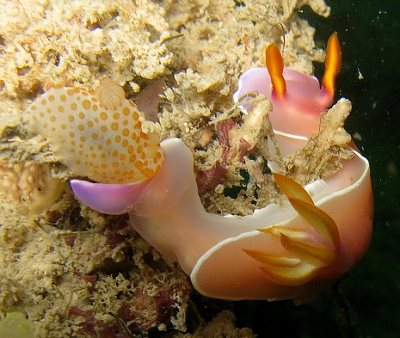
Thanks Chay Hoon,
It certainly seems that the hunting response in some of these 'hunting' nudibranchs (Gymnodoris, Roboastra ) is triggered by 'taste' or 'smell' and size is not taken into consideration. We tell children who take to much food that there 'eyes are bigger than their stomachs' but I guess since the eyes of these nudibranchs can't actually see images they can't judge when their target is inappropriately large.
Best wishes,
Bill Rudman
Re: Gymnodoris rubropapulosa & egg mass
April 15, 2008
From: Toh Chay Hoon
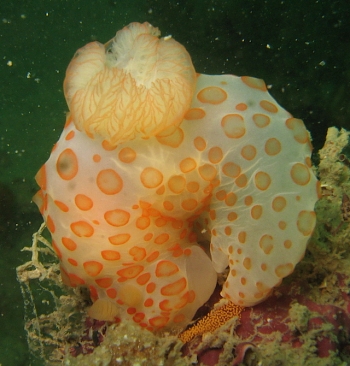
Concerning message #13391:
Dear Dr Bill,
Here's photo of Gymnodoris rubropapulosa laying an egg ribbon FYI.
Locality: Pulau Hantu, 10m, Singapore, South China Sea, 23 March 2008, Substrate rubbles with some reddish pink sponge?. Length: 50 mm. Photographer: Toh Chay Hoon.
Toh Chay Hoon
sonnenflower@gmail.com
Toh C.H., 2008 (Apr 15) Re: Gymnodoris rubropapulosa & egg mass. [Message in] Sea Slug Forum. Australian Museum, Sydney. Available from http://www.seaslugforum.net/find/21514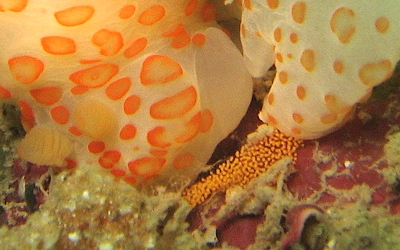
Thanks Chay Hoon,
Best wishes,
Bill Rudman
Re: Gymnodoris rubropapulosa feeding
April 10, 2008
From: Toh Chay Hoon
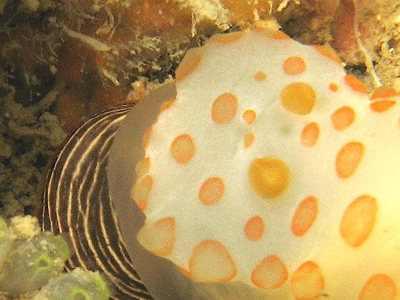
Concerning message #21507:
Dear Dr Bill,
I didn't want to deprive the Gymnodoris of its food so I did not disturb it while it was feeding.
But here's another photo of the same G. rubropapulosa feeding. Hope that it helps to make the prey's ID clearer.
I thought that it was Chromodoris lineolata as there's a orangy-red margin on the prey's mantle. In addition, C. lineolata is a more commonly spotted sea slug than Philinopsis lineolata at Pulau Hantu.
Locality: Pulau Hantu, 10 m, Singapore, South China Sea, 23rd April 2008, Substrate rubbles. Length: 50 mm. Photographer: Toh Chay Hoon.
Toh Chay Hoon
sonnenflower@gmail.com
Toh C.H., 2008 (Apr 10) Re: Gymnodoris rubropapulosa feeding. [Message in] Sea Slug Forum. Australian Museum, Sydney. Available from http://www.seaslugforum.net/find/21510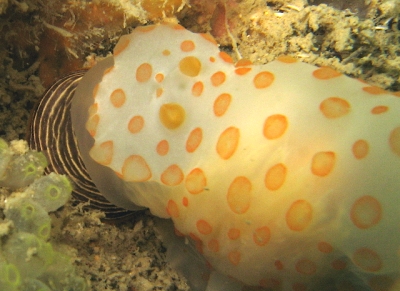
Dear Chay Hoon,
Thanks for the quick reply. Yes I can see the orange border in this photo so I agree it's C. lineolata. A very interesting addition to our knowledge.
Best wishes,
Bill Rudman
Re: Gymnodoris rubropapulosa feeding
April 9, 2008
From: Toh Chay Hoon
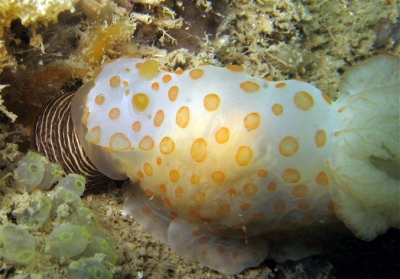
Concerning message #20926:
Dear Dr Bill,
Here's two photos of a Gymnodoris rubropapulosa feeding on a Chromodoris lineolata taken during a recent dive FYI.
Locality: Pulau Hantu, 12 m, Singapore, South China Sea, 23rd March 2008, Substrate rubbles. Length: 50 mm. Photographer: Toh Chay Hoon.
Toh Chay Hoon
sonnenflower@gmail.com
Toh C.H., 2008 (Apr 9) Re: Gymnodoris rubropapulosa feeding. [Message in] Sea Slug Forum. Australian Museum, Sydney. Available from http://www.seaslugforum.net/find/21507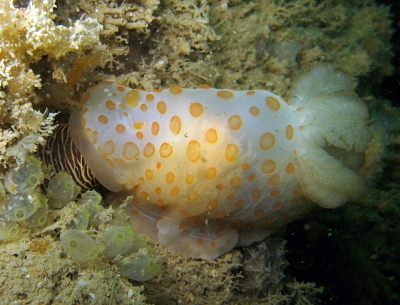
Dear Chay Hoon,
Thanks for this very interesting observation. When I looked at your photo before reading your message, my first thought was that the prey was Philinopsis lineolata being held at its posterior end. Did you have a look at the prey or did you decide not to disturb Gymnodoris while it was feeding? It would be nice if it was a chromodorid because it would suggest they target that family, but unless you have further information I cant be sure if it is Philinopsis or Chromodoris.
My plan this year is to finish a revision of the genus Gymnodoris which has been almost complete for about 5 years, so any other observations on feeding would be a valuable, and timely contribution.
Best wishes,
Bill Rudman
Gymnodoris rubropapulosa feeding
April 7, 2008
From: Kristin Anderson
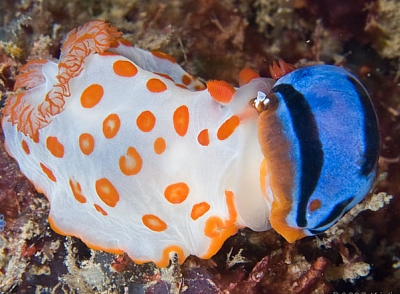
We noticed a distinct decline in the number of "usual" nudibranchs we saw over the weekend and an increase in the number (and size!) of some of the predator species.
I was thrilled to come across this action near the end of my last dive of the weekend. Both the Gymnodoris rubropapulosa and the Chromodoris westraliensis were pretty good sized (approx 2.5-3 cms for the Chromodoris)
Locality: Ningaloo Reef, Exmouth, 7m, Western Australia, Exmouth Gulf, 07 October 2007, tidal, silty, coral/limestone structures. Photographer: Kristin Anderson.
The sea flea didn't stick around very long ;)
Hope it benefits the Forum.
Kristin Anderson
kristin@oceansbyanderson.com
Anderson, K.J., 2008 (Apr 7) Gymnodoris rubropapulosa feeding. [Message in] Sea Slug Forum. Australian Museum, Sydney. Available from http://www.seaslugforum.net/find/20926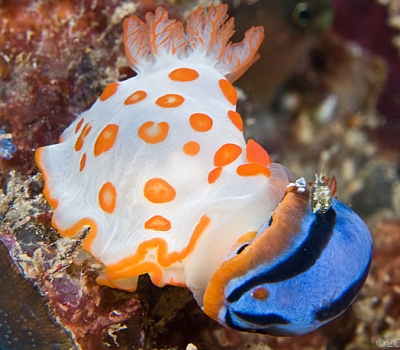
Dear Kristin,
It's always good to get records of these predatory hunters caught in the act. The act of catching and ingesting is often so quick that it's a wonder we ever actual see them feeding. I have had a couple of infuriating incidents when collecting with too few containers and having to have a large Gymnodoris share a container with a chromodorid. Inevitably the chromodorid 'disappears'. When this happens it's difficult to know whether this would happen naturally or whether the tempation was just too great for the Gymnodoris. It's certainly good to get an 'in the wild' rather than 'in the container' observation.
Best wishes,
Bill Rudman
Gymnodoris rubropapulosa & egg mass
March 25, 2005
From: Kristin Anderson
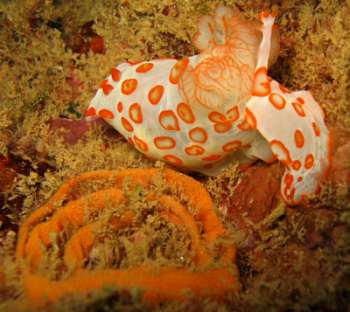
Dear Bill
Not sure if you have Gymnodoris rubropapulosa with eggs, so thought I would send it along. Although we had quite a few of these nudibranchs, this is the only one we have seen near an egg mass.
Locality: Ningaloo Reef, Western Australia, Exmouth Gulf. Depth: 12 m. Length: approx 4.5 cm. 10 January, 2005. silt bottom; man-made structure (Navy Pier). Photographer: Martina Fuchsberger.
Kristin Anderson & Martina Fuchsberger
kristin@exmouthdiving.com.au
Anderson, A. & Fuchsberger, M, 2005 (Mar 25) Gymnodoris rubropapulosa & egg mass. [Message in] Sea Slug Forum. Australian Museum, Sydney. Available from http://www.seaslugforum.net/find/13391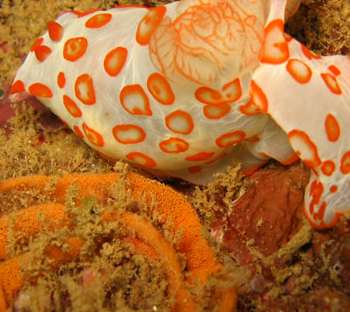
Dear Kristin & Martina,
It's certainly nice to get a photo showing the egg ribbon. I certainly have not seen one before
Best wishes,
Bill Rudman
Gymnodoris rubropapulosa from the Solomon Ids
July 25, 2003
From: Bruce Potter
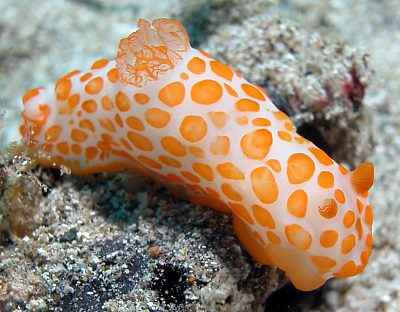
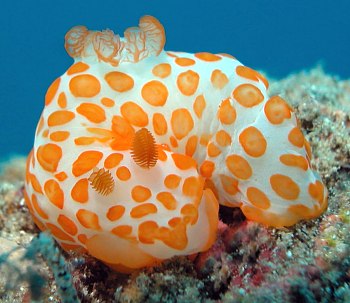
Dear Bill,
Even after 14 years of diving in Honiara, I still occasionally find something new. I found this Gymnodoris rubropapulosa yesterday on a coral and rubble site on the outskirts of Honiara.
It was about 25mm long, at 15m depth.
A few months ago I saw a very small Gymnodoris alba, which I did not photograph, which is a shame as I do not see it on the forum. A friend of mine did photograph it, but it did not come out very well.
Regards
Bruce Potter.
bruce.potter@adventist.org.sb
Potter, B., 2003 (Jul 25) Gymnodoris rubropapulosa from the Solomon Ids. [Message in] Sea Slug Forum. Australian Museum, Sydney. Available from http://www.seaslugforum.net/find/10135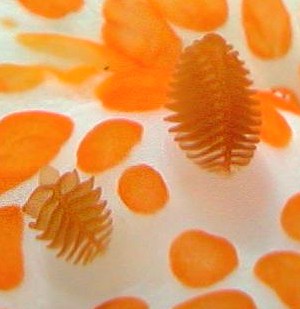
Thanks Bruce,
I have the feeling that if you wait long enough at any spot in the tropics, all the species reported from the region will eventually appear
Best wishes
Bill Rudman
Gymnodoris rubropapulosa from the Philipines
June 16, 2002
From: Fredy Brauchli
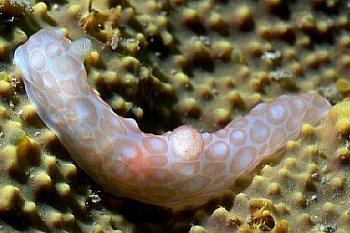
Hello Bill
Here is another interesting record. I am pretty sure that it is Gymnodoris rubropapulosa. As far as I know, it is uncommon that the spots are replaced by pale, light red rings. Nevertheless I think that it is another colour variant.
This image was taken at Pandan Island, Occ. Mindoro, Philippines.
Size: ca. 3,5 cm, depth: 13m, place: Canyons, date: April 1st 2002 .
Kind regards,
Fredy
brauchli@subaqua.ch
Brauchli, F., 2002 (Jun 16) Gymnodoris rubropapulosa from the Philipines. [Message in] Sea Slug Forum. Australian Museum, Sydney. Available from http://www.seaslugforum.net/find/7115Thanks Fredy,
We have a number of colour variants on the Forum including quite a spectacular ringed one of valda Fraser's from
South Africa.
Best wishes,
Bill Rudman
Gymnodoris rubropapulosa from Riau Archipelago
March 30, 2002
From: Alice Lee
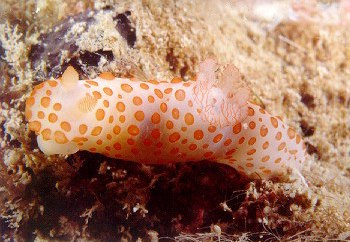
Hi Bill,
Here is a photo of Gymnodoris rubropapulosa taken on a wreck in Riau Archipelago, [Indonesia, just south of Singapore] it was about 30mm long and found at a depth of 15m.
Alice
alee@dlink.com.sg
Lee, A., 2002 (Mar 30) Gymnodoris rubropapulosa from Riau Archipelago. [Message in] Sea Slug Forum. Australian Museum, Sydney. Available from http://www.seaslugforum.net/find/6558Thanks Alice,
Bill Rudman
Gymnodoris rubropapulosa? from Singapore
March 14, 2002
From: John Yap Yee Kee
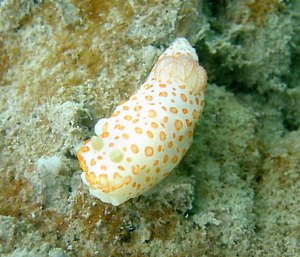
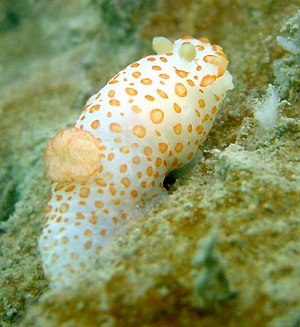
Hi Bill,
Here's a couple of shots I took at the south islands of Singapore yesterday {March, 2002].
Though I'm pretty sure it's the Gymnodoris rubropapulosa, the pale color of it's rhinophores cast a lingering doubt. And it wasn't moving as fast as described in your messages. In fact, I waited for a shot with a different posture, but could only settle for a different angle.
Cheers!
John Yap,
Singapore.
johnyap@TP.EDU.SG
Yap Yee Kee, John, 2002 (Mar 14) Gymnodoris rubropapulosa? from Singapore. [Message in] Sea Slug Forum. Australian Museum, Sydney. Available from http://www.seaslugforum.net/find/6417Dear John,
Yes this is Gymnodoris rubropapulosa. Sometimes there is no orange on the rhinophores. Concerning its 'sluggishness' - even though gymnodorids are 'hunters' and can move at times quite quickly, they also spend a lot of time meditating.
Cheers,
Bill Rudman
Ringed Gymnodoris rubropapulosa
March 26, 2001
From: Drew Taylor
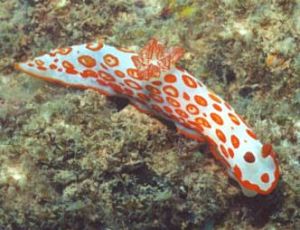
Dear Bill,
I have attached a photo of what I believe to be Gymnodoris rubropapulosa.
During the months of September - November, 2000 I came across this species numerous times while diving in the Exmouth Gulf [NW Australia]. Each time I observed this species it was showing orange rings and not orange spots.
The depth range was between 3-8 metres and I have not seen it since.
Regards
Drew Taylor
orcaunderwater@nwc.net.au
Taylor, D., 2001 (Mar 26) Ringed Gymnodoris rubropapulosa. [Message in] Sea Slug Forum. Australian Museum, Sydney. Available from http://www.seaslugforum.net/find/4038Thanks Drew,
Yes I am sure its G. rubropapulosa, but it's good to get another record of this ringed colour form.
Best wishes,
Bill Rudman.
Gymnodoris rubropapulosa from Gulf of Oman
January 19, 2001
From: Gordon T. Smith
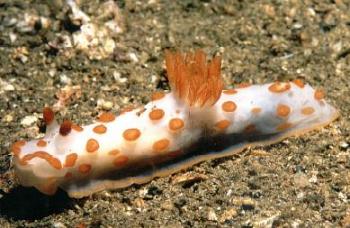
Dear Bill,
On reviewing my photographs of Gymnodoris rubropapulosa and comparing them to other specimens, the Gulf of Oman species does not seem to have as many orange spots (see photo). I was amazed at how fast these creatures travel also. This example was found (along with 2 others) in 15 metres of water and was approximately 4 cm long.
Gordon
aquashot@emirates.net.ae
Smith, G.T., 2001 (Jan 19) Gymnodoris rubropapulosa from Gulf of Oman. [Message in] Sea Slug Forum. Australian Museum, Sydney. Available from http://www.seaslugforum.net/find/3532Dear Gordon,
Gymnodorids certainly seem to be less 'sluggish' than many nudibranchs. perhaps it is the nature of their diet. I guess if you hunt moving prey like gymnodorids do, it is more important to be able to move quickly than if you feed on things that don't move, like sponges.
Concerning colour differences. Have a look at my photo at the top of the page from Koumac, New Caledonia. You will see a pair of animals, one with the white background and relatively sparse orange spots, like your photo, with a more 'typical animal with trnslucent background and closer and larger orange spots. I can find no anatomical differences between the two colour forms which can occur together.
Best wishes,
Bill Rudman
Gymnodoris rubropapulosa from South Africa
December 31, 2000
From: Valda Fraser
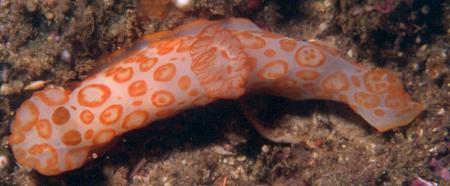
Dear Bill
Here is Gymnodoris rubropapulosa to welcome you back.
Locality: Sodwana, north coast KwaZulu-Natal, SOUTH AFRICA, 18m
Date: Nov 2000
Size: 55mm
Regards
Valda Fraser
valdafraser@mweb.co.za
Fraser, V., 2000 (Dec 31) Gymnodoris rubropapulosa from South Africa. [Message in] Sea Slug Forum. Australian Museum, Sydney. Available from http://www.seaslugforum.net/find/3324Thanks Valda,
I remember the first time I found this species in Tanzania, its brilliant colouration making it very obvious amongst the sea grass. I have never seen one in which the orange spots have been replaced by rings, but I would be very surprised if it was more than just a colour variant.
Best wishes,
Bill Rudman
